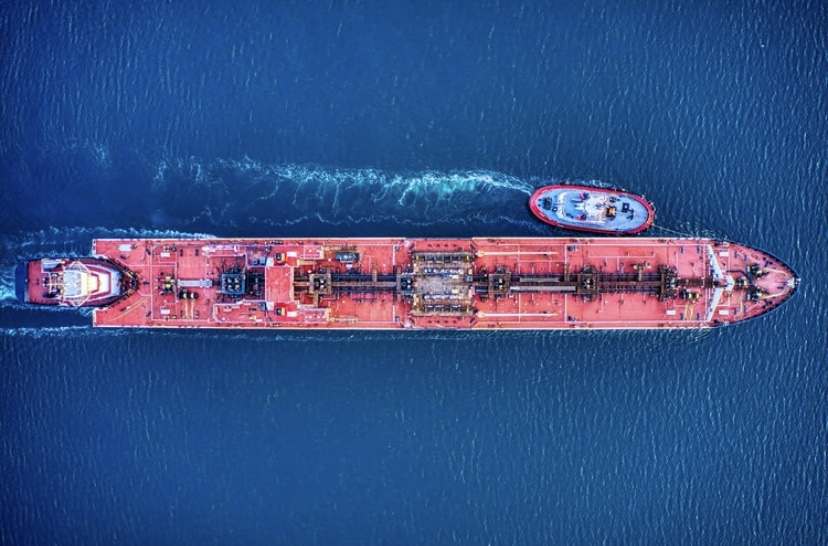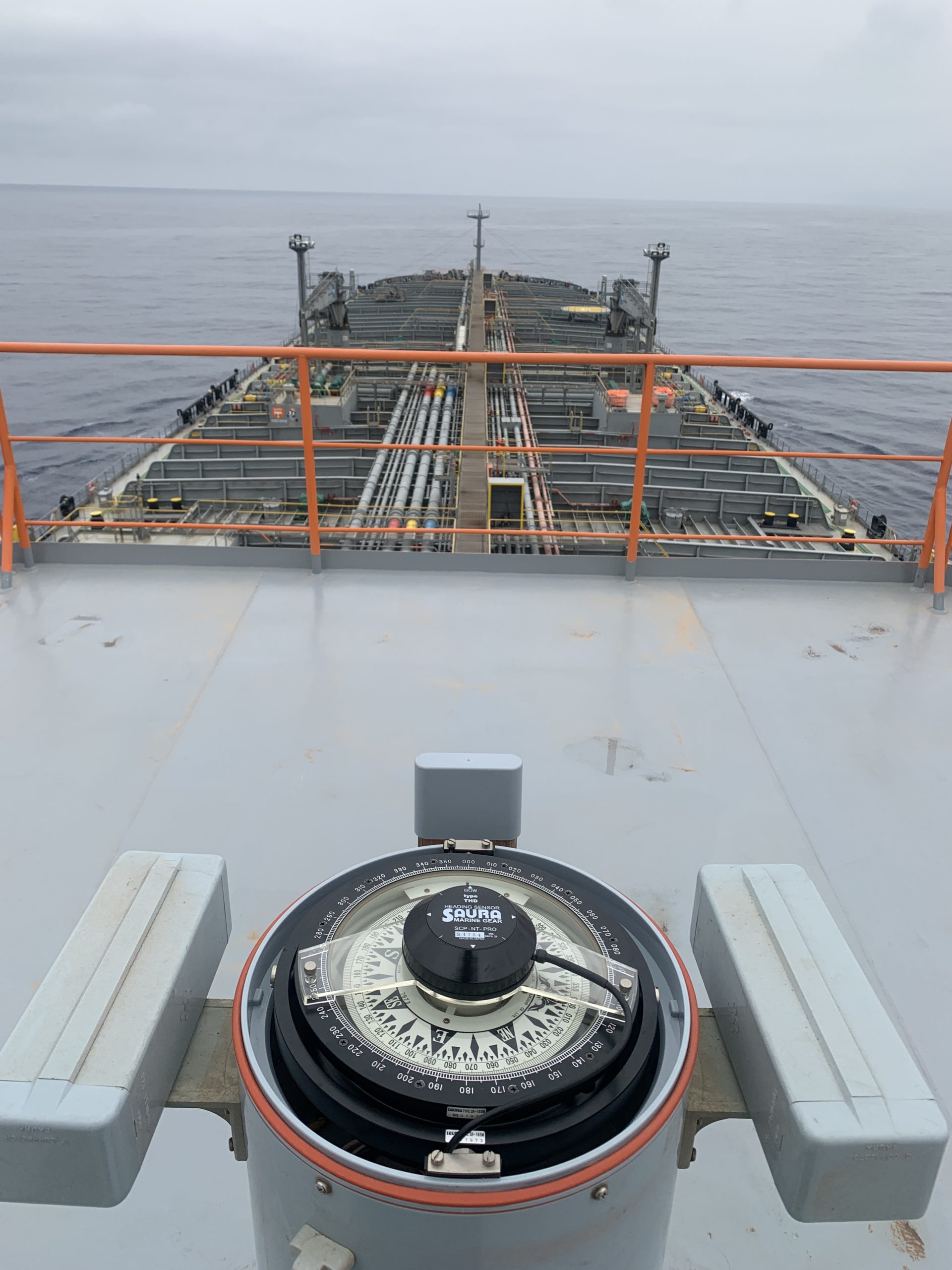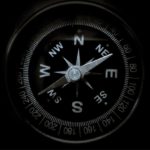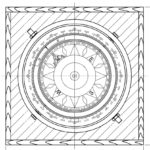Magnetic compass coefficients
As in the last article, we discussed about the magnetism. Now we will try to understand what are the coefficients of magnetic compass and how they affect our magnetic heading.
Table of contents
Components of ship’s magnetic field
You know that building a ship takes a very long time, efforts and energy. So while in yard, the ship is heading in a constant direction for a very long time. Thus the earth’s magnetic field is passing through the ship for a period of time.

So the hard iron structure of the ship gets magnetised by permanent magnetism.
As for such a long time, the magnetic lines of the earth’s magnetic field enter and exit from the ship’s structure. The ship structure attains magnetic poles where the earth’s magnetic lines enter and exit
Suppose the earth’s magnetic lines entering at stern of the vessel and exiting at the foc’le of the vessel.
Then the blue pole will form at the stern of the vessel and the red pole will be formed at the foc’le of the vessel.
Thus the horizontal positioning of the poles depends upon the heading of the ship when it was being built.

Now again, we come to the ship’s heading to understand the horizontal positioning of the poles and magnetism.
But the heading can be anywhere between Magnetic north or magnetic south. So it is not necessary that the magnetic lines enter from stern or foc’le.
Suppose that the ship’s heading is 045 degree. Than the magnetic lines will enter somewhere between stern and midship, And exit just opposite to that.
Thus in order to correctly calculate the total magnetism, we divide the horizontal component into two more sub components.
The horizontal component is divided into two more components called the “Forward and Aft Horizontal component (in short- F & A component)” and “athwartship horizontal component”.
So now there are three components of ship’s magnetic field due to her permanent magnetism.
The components are due to the ship’s permanent magnetism are:
– F & A horizontal component (Force P)
– Athwartship horizontal component (Force Q)
– Vertical component (Force R)
Similarly due to the Induced magnetism in ship’s soft iron there are three components:
– F&A horizontal component
-Athwartship component
-Vertical component
Now in case it is not clear about why these components are so important and why are they being discussed.
As you know that if you are ill and go to a doctor, and you don’t tell him your symptoms. Then he will not be able to give you better treatment.
Same way, a magnetic compass on a wooden boat, showing heading without any deviation is like a perfect healthy body. Because on wooden boat there is nothing that will affect it’s heading.
Now the same magenetic compass is brought and installed on a vessel built of iron and steel.
So now there are too many materials are there which will affect it’s heading. And it won’t be able to show the correct heading.
But if we know the correction value called “deviation”. We can apply it on the magnetic heading in order to correct it for ship’s permanent as well as induced magnetism.
Thus the components are the symptoms and we have to obtain the correction value called in order to cure it. That’s it, it is as simple as that.
And the deviation is obtained by summing up these coefficients in a formula.
Magnetic compass coefficients
The coefficient is the max deviation caused by one or more of ship’s magnetic forces acting at the compass position affecting the magnetic heading.
There are 5 coefficients named coefficients A, B, C, D & E.
So if we know the value of these 5 coefficients, we will know total deviation caused by these coefficients and thus will be able to correct the heading.
And the total deviation on ship’s course is obtained by the following formula:
Total deviation = A + B sin(course) + C cos(course) + D sin(2 course) + E cos(2 course)
It means that if we have the values of all coefficients, we will know the value of total deviation onboard ship.
So let’s get to know these coefficients one by one.
Coefficient A
Coefficient A is subdivided into two sub coefficients called the real A and the apparent A.
The other thing about coefficient A is that it is a constant deviation in value. Value means the amount and the name of the deviation will be same in all directions and all latitudes.
The Real A is caused by the induced magnetism in the unsymmetrical pairs of horizontal soft iron around the compass
While the Apparent A is caused by some constant factors other than the ship’s magnetism.
The things affecting the apparent A are:
- The lubber line(axis of magnetic compass) not being parallel to the ship’s heading.
- Error in observing the magnetic heading.
- Error in computing the magnetic bearing of an object or ship’s heading.
- Taking bearing while swinging the ship rapidly.
- Other calculation error.
So in order to remove the apparent A, the above errors should be removed by checking lubber line alignment, azimuth mirror, variation and checking the calculations.
The coefficient A may be obtained by taking the average of the deviations on at least four headings which are at equal distance from each other.
Coefficient B
Coefficient B is the maximum amount of semicircular deviation, which changes with the sine of compass course.
The coefficient B error is maximum on East or west headings. While it’s lower on other headings.
Again it is divided into two more sub coefficients. The coefficients are Permanent B and Induced B.
Permanent B is the F & A horizontal component of ship’s magnetic field at the compass position.
The value of B will be positive(+B) if this field acts in fwd direction.
While the B will be negative(-B) if this field acts towards the stern direction.
So suppose that the ship is built on a heading of 180°(Southerly heading). So the lines of earth’s magnetic field are entering on the ship from the bow and exiting from the stern.
Thus the ship will acquire the red pole on the stern and blue pole on the bow.
One thing to remember is that, from where the magnetic lines enter, the blue pole forms.
While the place from the magnetic lines exit, the red pole forms.
So as we have the value of permanent B, which is corrected by placing the F&A magnets having equal and opposite amount of magnetism that of ship.
Induced B is caused by horizontal F & A magnetic field at the compass, due to the induced magnetism in the vertical soft iron on ship in fwd and aft of the compass. 
As we know that the materials made of soft iron are affected by the induced magnetism.
And we have a few structures near the compass, made of soft iron. Which get magnetised by the infected magnetism very easily.
The structures include the funnel and the masts fwd or aft of compass.
So let’s assume the case, that we are in northern hemisphere. So the structures made of soft iron will acquire the blue pole at the top and the red pole at bottom.
The poles reverses in case we are in south hemisphere.
So in order to correct the induced B, we use the flinder bars. Flinder bars are situated adjacent to the compass binnacle either fwd or aft of it.
The flinder bars are of cylindrical shape, made of fixed diameter but vary in lengths.
So the bars are used as required in order to remove the effect of induced B.
Coefficient C
Coefficient C is caused because of the horizontal athwartship components of ship’s magnetic field.
Now, like the earlier coefficients, coefficient C is again divided into two components.
The components are called Permanent C and the Induced C.
Permanent C is caused by the horizontal athwartship component of ship’s permanent magnetic field at the compass position.
Just like we discussed earlier, the permanent magnetism depends mostly on the heading ship was built.
So if the heading was north or south, then only fwd and aft magnetism will be acquired by the ship.
But if it is built in east or west direction, then the magnetic field lines will be entering from one side of the ship and exiting on the opposite side.
Let’s take an example, that the ship is built on westerly heading, then the lines will enter from port side and exit from starboard side.
And we have highlighted above, the blue pole forms on the port side(as the lines enter on port side), while the red pole forms on starboard side(from where the magnetic lines exit).
As we know now the value of the permanent C, we can correct it with placing the magnets having same amount of magnetism but in opposite direction.
So the permanent C is corrected by placing magnets in Athwartship horizontal direction, having equal and opposite amount of magnetism.
While the Induced C is caused by the horizontal Athwartship magnetic field at the compass position, due to induced magnetism in vertical soft iron to the port and starboard of the ship.
But if we see it practically, the compass is placed on the centre line of the ship.
And the structures are almost identical on port and starboard side of the compass.
Thus the amount of Induced magnetism is either zero or negligible.
That’s why, the correction of the induced C is not required.
In rare case, if it is required, then it can be corrected by placing flinder bars in port or starboard side of the binnacle generating equal and opposite amount of induced magnetism.
Coefficient D
Coefficient D is a bit different from earlier discussed coefficients.
Coefficient D is the maximum amount of quadrantal deviation, which changes with the “sine” of twice the compass course.
While the induced B and induced C were caused because of the vertical soft irons.
The coefficient D is caused by the horizontal field at the compass position because of the induced magnetism in the horizontal soft iron, which are situated symmetrically on the fwd and aft line.
Mostly ships have +D at the compass position because of the ship structure and the position of beams and girders.
+D is corrected by generating equal amount of -D.
So the -D is generated by the Soft iron spheres, which you can always see situated on both sides of the compass.
The amount of -D is changed by shifting the spheres closer or away from the compass.
Coefficient E
Coefficient E is the max amount of quadrantal deviation changing with the cosine of the compass course.
Coefficient E is caused by the horizontal field at the compass position, because of the induced magnetism in horizontal soft iron, placed symmetrically about a 45° line through the compass position.
The catch over here is the word “symmetrical”. As we know that through 45° line, it’s very rare that we find anything symmetrical.
Thus practically the coefficient E is absent on most ships.
But, if it is present, it can be corrected by placing the S.I. Spheres to 45° from the fwd and aft line.
Coefficient D and Coefficient E can be corrected together by slewing the spheres to an angle which generates equal and opposite amount of deviation nullifying the coefficients D and E.


